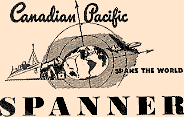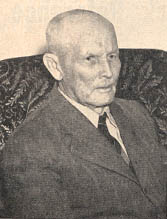
1947-1971
|

Horse-Drawn Flat Cars Recalled by
Pioneer
 Turfmen weren't the only people demanding lightweight jockeys back in
the 80's, Ken Liddell, Calgary Herald feature writer, discovered on a recent trip to
High River. In his "Furrows and Foothills" series he revealed that CPR
construction men too liked riders that weighed next to nothing soaking wet for the
job of hauling rails for the pioneer track layers.
Turfmen weren't the only people demanding lightweight jockeys back in
the 80's, Ken Liddell, Calgary Herald feature writer, discovered on a recent trip to
High River. In his "Furrows and Foothills" series he revealed that CPR
construction men too liked riders that weighed next to nothing soaking wet for the
job of hauling rails for the pioneer track layers.
Liddell tells it this way:
After riding a horse from Moose Jaw to Field helping the Canadian Pacific Railway get
started, Alexander G. Stewart figured he'd seen enough, so he hasn't been anywhere of
any consequence since.
"Oh, I've been away for a day or two", he told the High River old timers at
their big "do" recently, "but I've never taken a holiday. Always had
enough to do at home and always had a good home."
Which was probably the nicest compliment Mrs. Stewart, a happy woman with an
infectious smile, could ever receive.
She shares her husband's memories of the early days around High River, and if you've
ever visited their attractive home where they live in the town you'd understand Mr.
Stewart's feelings that farther fields only look greener.
But when Alexander Stewart moved westward there was plenty of field and not much on
it.
It was in 1882 and Stewart said his parents - originally from Scotland - were living
near Montreal, where Stewart was born in 1867, when they decided to come west "to
grow up with the country".
They were somewhere between Regina and Moose Jaw when the train stopped because the
track stopped so Stewart, then "just a wee bit of a kid", took on a man's
job to help them lay the rails onward at a dollar a day.
In this thin, slight man, High River has a citizen who participated in an event that
in its importance could be coupled with Confederation itself, but he said the
historical significance of it never occurred to him at the time.
To him it was just a long ride on horse back.
He said he handled the job he had because the railway was "looking for fellows
as light as they could get em'", due to the fact it was quite a chore for the
horses to pull the rails apart from having a heavy jockey, too.
The construction train would bring the rails to within half a mile of
steel-end and there the rails were dumped.
The job Stewart had, along with his horse, was to haul the rails from there to the
point where they were laid.
The rails were hauled on a small flat car, pulled by the horse which Stewart rode,
and on the way back the construction workers used the conveyance as a taxi and
Stewart recalled he gave some of them a "right smart ride".
"When you look back", he said, "it really was something to see. There
wasn't a house to the horizon. Nothing but this gang of men working forward".
"And the speed with which they worked was remarkable", he recalled. "It
seemed they would lay half a mile of track in a matter of minutes, but of course it
wasn't that fast. But I always remember the great noise there was when they beat the
world's record for some distance or other".
Stewart followed the gang right to Field, BC, and then his father, Maurice Stewart,
opened a hotel at Canmore. He ran it for two years before moving in 1885 to a
homestead at Davisburg, in the High River district, with Alexander and another son,
William.
©
2005 William C. Slim
http://www.okthepk.ca
|
|
|

